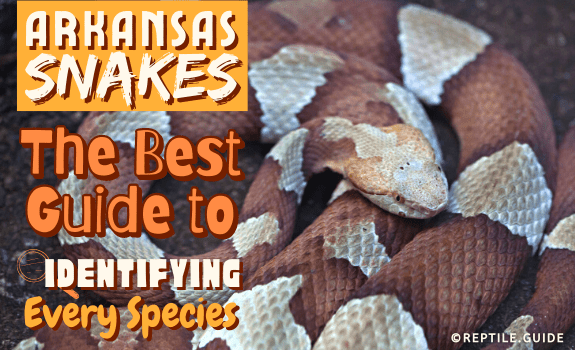Arkansas snakes come in various forms, colors, and sizes. Venomous snakes range from the tiny Western pygmy rattlesnake to the huge Western diamondback rattlesnake.
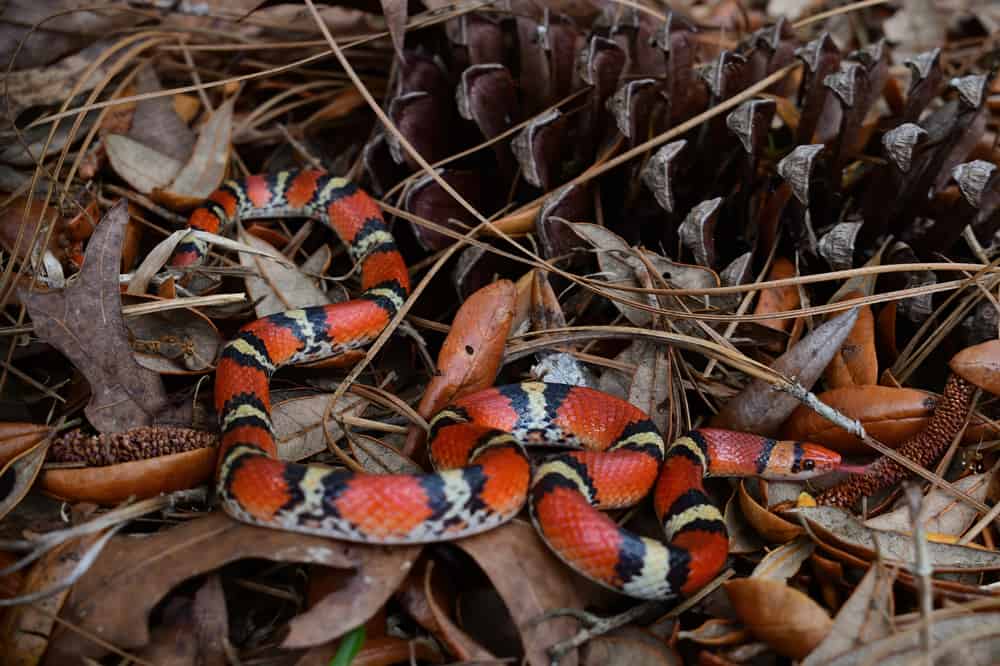
Non-venomous snakes feature everything from tiny worm snakes to the black rat snake and North American racer.
In This Article
In Short
This Arkansas snake guide takes a closer look at the snakes found in the region and how to protect yourself. Among other things, I’ll look at:
- Identifying snakes in Arkansas
- Venomous snakes found in Arkansas
- The most common snakes found in Arkansas
- How to keep yourself and your loved ones safe from snake bites
I’ll also share some useful resources for dealing with snakes and share images of various snakes found in the region.
Arkansas Snake Identification Basics
When you’re learning to identify snakes and other animals, there are a few things you need to bear in mind. Specifically, these are:
- The animal’s length
- Its head and pupil shape
- Its pattern and coloration
- Its habitat type and geographic locality
While none of these characteristics are definitive on their own, the combination of all four can provide a conclusive identification.
I’ll take a look below, and explain each characteristic.
Length
When working with lengths, there are two different lengths you should be aware of:
- The snake’s average length
- The snake’s maximum length
Every species of snake has a length that it typically reaches. This is known as its average length, and you’re most likely to see snakes of that size.
Sometimes, a snake grows bigger than most other snakes of that species.
Scientists take the lengths of the longest animals to form the maximum length- the absolute largest size a species can reach.
By knowing both the average length and the maximum length, you can usually tell whether a snake could belong to a specific species.
For example, the small maximum size of a pygmy rattlesnake means that you can’t possibly mistake a timber rattlesnake for a pygmy.
The only exception is in the case of baby and juvenile snakes. Since they’re not yet full-grown, they’re often much smaller than the adults and are easy to confuse for other snakes.
Locality and Habitat Type
Most snakes have a preferred habitat type from which they rarely move. By taking note of the habitat type where you find a snake, you can narrow down its identification.
For example, water snakes and the water moccasin rarely live away from freshwater habitats. However, the timber rattlesnake prefers forested mountainsides away from water.
Some snakes are the exception, like garter snakes and the black rat snake – they live wherever food is abundant.
The geographic location where you find a snake is also of importance. Most snakes have a specific distribution.
By checking an Arkansas snake guide with good distribution maps, you can see if a species occurs in the region where you found the snake. If not, you know the snake is something else.
Head and Pupil Shape
Different families and genera of snakes often have different pupil shapes. The three well-known pupil shapes for snakes are:
- Round
- Vertical
- Horizontal
In Arkansas, you’ll only encounter vertical (slit-shaped) and round pupils.
Most venomous snakes in this region are pit vipers and have vertical pupils. All the other species, including the coral snake, have round pupils.
The shape of the head is another identification characteristic. For example, pit vipers have squat, wide heads, and rat snakes have rounded heads that are the same width as the snake’s body.
Color and Patterning
Although coloration and patterning vary significantly, even within a species, these things can be useful identification characteristics.
For example, if you find black snakes in Arkansas you won’t start by looking at the rough greensnake, or the coral snake with its bright yellow bands.
You’ll look at species like the black rat snakes, which are naturally black. A snake with speckles could be a speckled kingsnake or a water snake, but it isn’t a timber rattlesnake.
Quickly Identifying Venomous Snake Species
Since there are only six venomous snake species in Arkansas, identifying them is fairly simple. Five of the six are vipers, and the sixth is a coral snake. Let’s have a look at how to identify them.
Pro Tip: While people often search for poisonous snakes in Arkansas, snakes are venomous and not poisonous. Poison kills you if you eat it, but venom gets injected into your body.
Most of the Venomous Snakes Found in Arkansas Are Pit Vipers
A pit viper is fairly easy to identify. These venomous species share the following characteristics:
- Large eyes with vertical, slit-shaped pupils
- A robust, thick body with strong musculature
- Large, heat-sensing pits between the eyes and the nostrils
- The tail scales are modified to form a sound-producing “rattle” (only in rattlesnakes)
- They have neutral colors like browns and greys that blend well with leaf litter and other substrates
Every species of pit viper in the area has these basic qualities, though there may be some variation.
Identifying Coral Snakes
Coral snakes are brightly colored snakes that are difficult to mistake for other snakes. The only species that look remotely like them are the scarletsnake, groundsnake, and milk snakes.
If you know what you’re looking for, they’re easy to tell apart. Coral snakes have the following characteristics:
- A rounded head
- Small eyes with round pupils
- Bright black, red, and yellow bands
Folks who live near this venomous snake have written nursery rhymes to help identify them:
“Red next to yellow, kill a fellow. Red next to black, a friend of Jack.”
In a coral snake, the red bands are next to the yellow bands. In most other snakes with similar coloration, the red bands are next to black bands.
Some snakes may be aberrant – they don’t have the typical coloration and patterning. So, while these rhymes are often useful they’re not always accurate.
You can only rely on these rhymes in North America. In other countries, they may lead you into trouble, rather than keeping you safe.
Which Snakes Live in Arkansas?
Arkansas has approximately 40 species of snakes. Of those, only the following six species are venomous snakes:
Pit Vipers
-
- Agkistrodon contortrix – Eastern Copperhead
- Agkistrodon piscivorus – Northern Cottonmouth
- Crotalus atrox – Western Diamond-backed Rattlesnake
- Crotalus horridus – Timber Rattlesnake
- Sistrurus miliarius – Pygmy Rattlesnake
Coral Snake
-
- Micrurus tener – Texas Coralsnake
Many of the non-venomous snakes of Arkansas fit neatly into one of the following groupings:
Worm Snakes
-
- Carphophis amoenus – Eastern Worm Snake
- Carphophis vermis – Western Worm Snake
Milk Snakes and Kingsnakes
-
- Lampropeltis calligaster – Prairie Kingsnake
- Lampropeltis gentilis – Western Milk Snake
- Lampropeltis holbrooki – Speckled Kingsnake
- Lampropeltis triangulum – Eastern Milk Snake
Watersnakes
-
- Nerodia cyclopion – Mississippi Green Watersnake
- Nerodia erythrogaster – Plain-bellied Watersnake
- Nerodia fasciata – Banded Watersnake
- Nerodia rhombifer – Diamondback Watersnake
- Nerodia sipedon – Common Watersnake
Ratsnakes and Cornsnakes
-
- Pantherophis emoryi – Great Plains Ratsnake
- Pantherophis obsoletus – Western Ratsnake
- Pantherophis slowinskii – Slowinski’s Cornsnake
Queensnakes and Crayfish Snakes
-
- Regina grahamii – Graham’s Crayfish Snake
- Regina septemvittata – Queensnake
Brownsnakes
-
- Storeria dekayi – Dekay’s Brownsnake
- Storeria oipitomaculata – Red-bellied Snake
Garter and Ribbon Snakes
-
- Thamnophis proximus – Western Ribbon Snake
- Thamnophis sirtalis – Common Garter Snake
The other non-venomous snakes in the region are singular representatives of their genera:
- Liodytes rigida – Glossy Swampsnake
- Tantilla gracilis – Flat-headed Snake
- Haldea striatula – Rough Earthsnake
- Virginia valeriae – Smooth Earthsnake
- Farancia abacura – Mudsnake
- Pituophis catenifer – Gopher Snake
- Coluber constrictor – North American Racer
- Cemophora coccinea – Scarletsnake
- Opheodrys aestivus – Rough Greensnake
- Diadophis punctatus – Ring-necked Snake
- Sonora semiannulata – Ground Snake
- Heterodon platirhinos – Eastern Hognose Snake
- Masticophis flagellum – Coachwhip
- Tropidoclonion lineatum – Lined Snake
Most Common Snakes in Arkansas
According to iNaturalist, the following species are the most common snakes in Arkansas.
I’ll discuss the venomous snakes in a different section, and some of these species are mentioned elsewhere in the article.
- Western Ratsnake – Pantherophis obsoletus
- Ring-necked Snake – Diadophis punctatus
- Speckled Kingsnake – Lampropeltis holbrooki
- Northern Cottonmouth – Agkistrodon piscivorus
- Dekay’s Brownsnake – Storeria dekayi
- Common Garter Snake – Thamnophis sirtalis
- Eastern Copperhead – Agkistrodon contortrix
- Plain-bellied Watersnake – Nerodia erythrogaster
- Rough Greensnake – Opheodrys aestivus
- North American Racer – Coluber constrictor
Ratsnakes and Cornsnakes
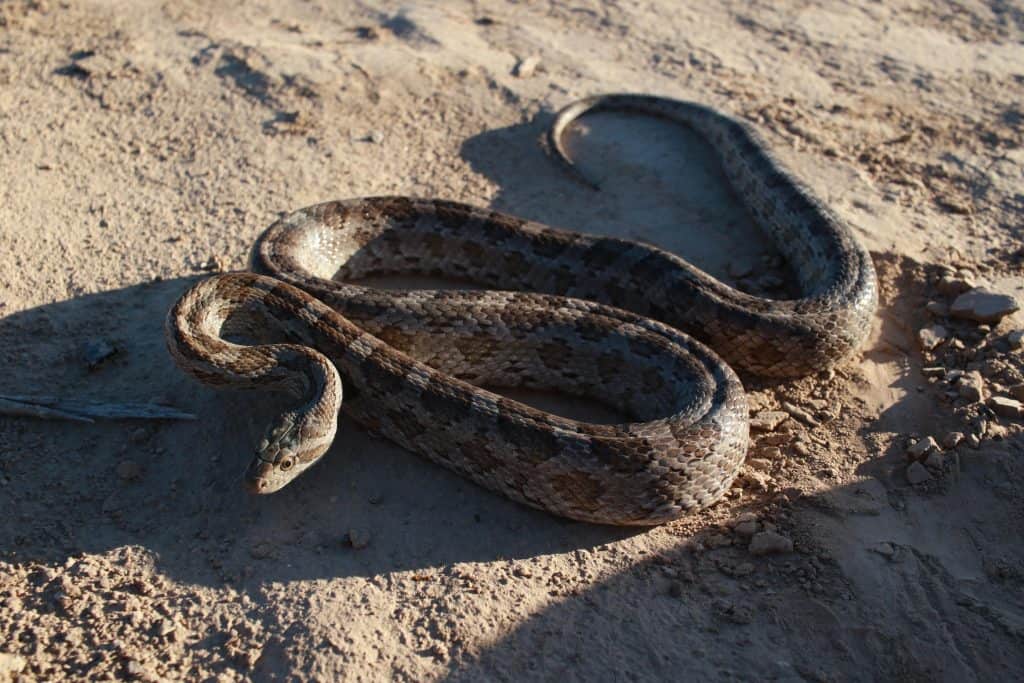
Image credit: u/RubenGamez (via Reddit.com)
The rat snake is a beautiful non-venomous snake that gets its name from its preferred diet of rodents.
Corn snakes often live in cornfields where they feed on field mice and voles.
| Scientific Name: |
Pantherophis emoryi – Great Plains Ratsnake Pantherophis slowinskii – Slowinski’s Cornsnake Pantherophis obsoletus – Western Ratsnake |
| Range: | Throughout the state |
| Adult Size: | 36 to 72 inches |
| Description: |
Slightly keeled scales. Black or brown with lighter bands or speckles. Narrow-looking heads with round pupils. |
| Habitat: | Habitat generalists, but often in forests and woodlands |
| Venomous/Non-Venomous: | Non-Venomous |
Kingsnakes
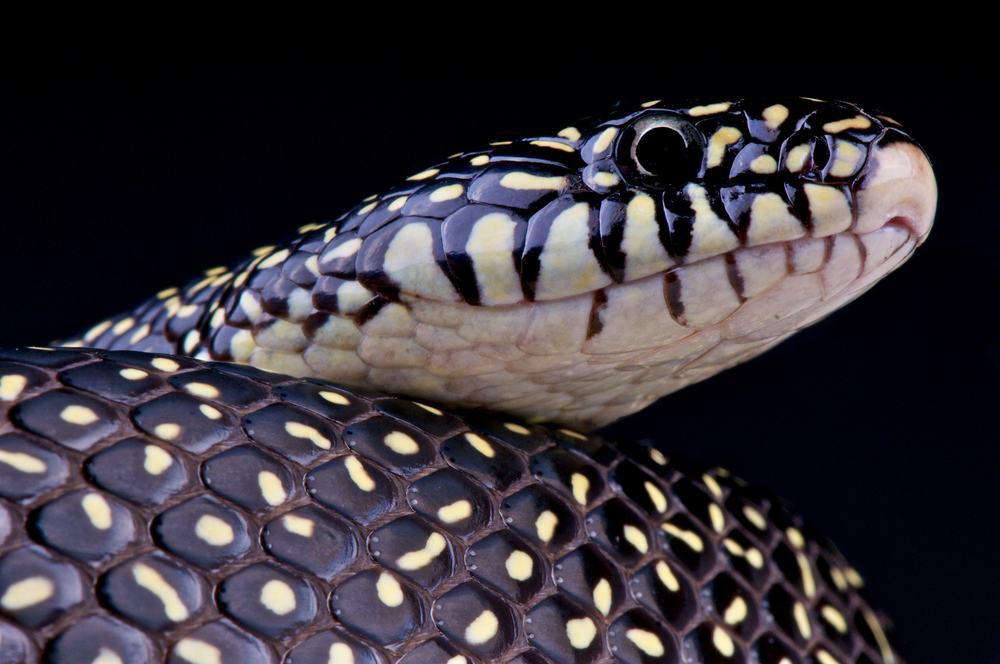
The kingsnake, or king snake, in Arkansas, is a common resident of fields and gardens where food sources are plentiful.
| Scientific Name: |
Lampropeltis gentilis – Western Milksnake Lampropeltis holbrooki – Speckled Kingsnake Lampropeltis calligaster – Prairie Kingsnake Lampropeltis triangulum – Eastern Milksnake |
| Range: | Throughout the state |
| Adult Size: | 16 to 48 inches |
| Description: |
Significant variance between species. Milk snakes have bands while kingsnakes have speckles or blotches. Colors range from cream to tan, red, and white. Robust bodies lead to a head of equal width with round pupils. |
| Habitat: | Forests, woodlands, pastures, and prairies |
| Venomous/Non-Venomous: | Non-Venomous |
Brownsnakes
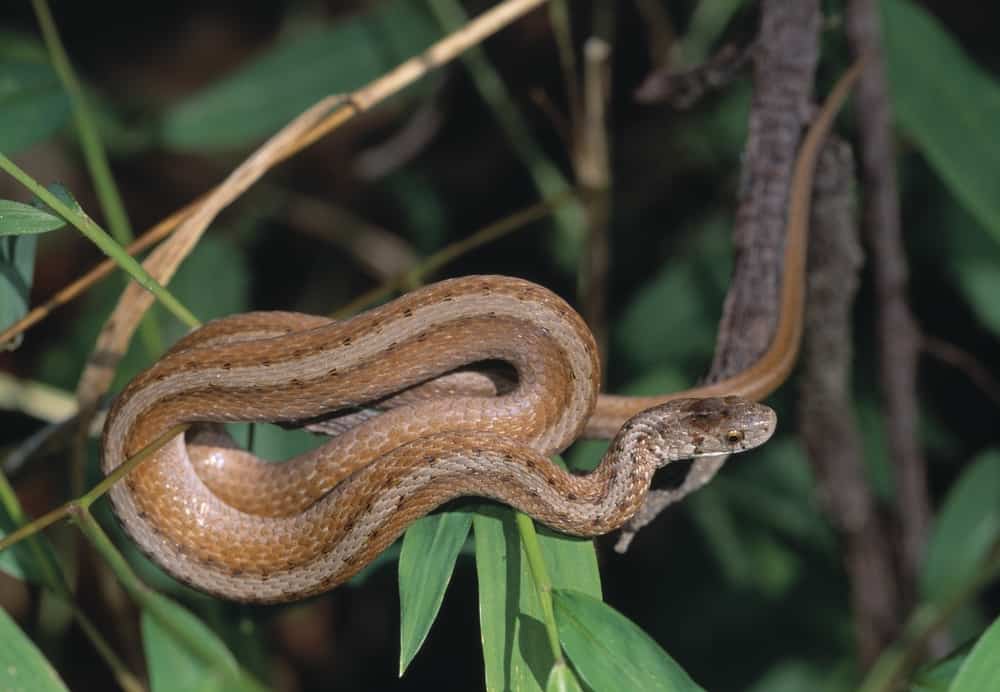
Brownsnakes are small, non-venomous snakes that live in moist habitats and feed mainly on slugs and snails.
| Scientific Name: |
Storeria dekayi – Dekay’s Brownsnake Storeria oipitomaculata – Red-bellied Snake |
| Range: | Throughout the state |
| Adult Size: | 9 to 13 inches |
| Description: |
Small snakes with rounded heads and round pupils. Various shades of brown or gray with a light vertebral stripe, and possibly speckles. The red-bellied snake has a bright red belly. |
| Habitat: | Habitats with moist soils, specifically forests, woodlands, swamps, and marshes |
| Venomous/Non-Venomous: | Non-Venomous |
Garter Snakes and Ribbon Snakes
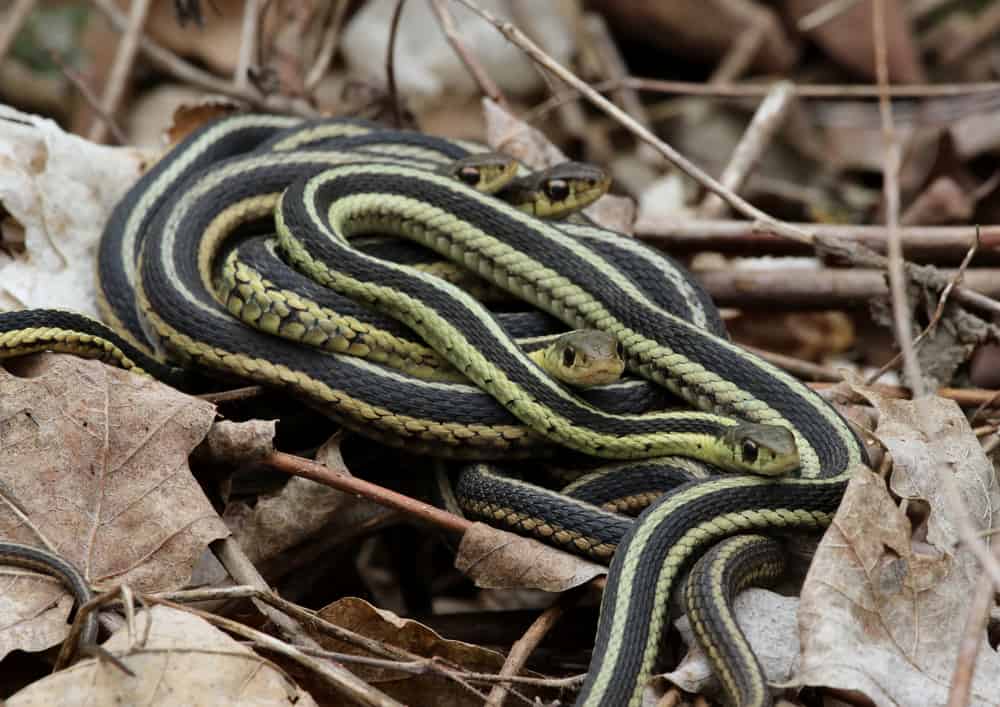
It’s almost hard not to find a garter snake in Arkansas. These semi-gregarious snakes are habitat generalists that live wherever food is plentiful.
| Scientific Name: |
Thamnophis proximus – Western Ribbon Snake Thamnophis sirtalis – Common Garter Snake |
| Range: | Throughout the state |
| Adult Size: | 18 to 30 inches |
| Description: |
Long narrow snakes with three to five vertebral stripes. Colors range from brown to black and yellow. A slightly triangular head with round pupils. |
| Habitat: | Habitat generalists, but often wet habitats like the edges of marshes and swamps |
| Venomous/Non-Venomous: | Non-Venomous |
Water Snakes in Arkansas
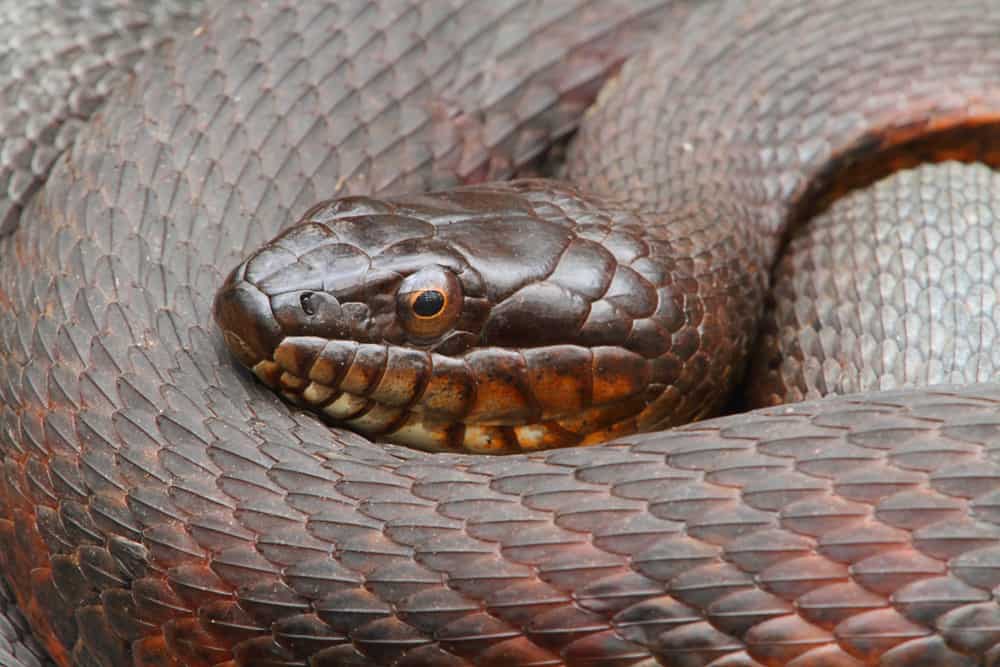
There are several types of water snakes in Arkansas, and they’re common wherever there’s fresh water with plenty of fish and amphibians.
| Scientific Name: |
Nerodia sipedon – Common Watersnake Nerodia fasciata – Banded Watersnake Nerodia cyclopion – Mississippi Green Watersnake Nerodia rhombifer – Diamondback Watersnake Nerodia erythrogaster – Plain-bellied Watersnake |
| Range: | Throughout the state |
| Adult Size: | 24 to 60 inches |
| Description: |
Black, brown, or gray. May have stripes, bands, blotches, or diamonds. The head is slightly wider than the body and has round pupils. |
| Habitat: | Any habitats sporting fresh water and plenty of food sources |
| Venomous/Non-Venomous: | Non-Venomous |
Venomous Snakes in Arkansas
There are only six venomous snake species in Arkansas – one coral snake and five vipers.
Copperhead
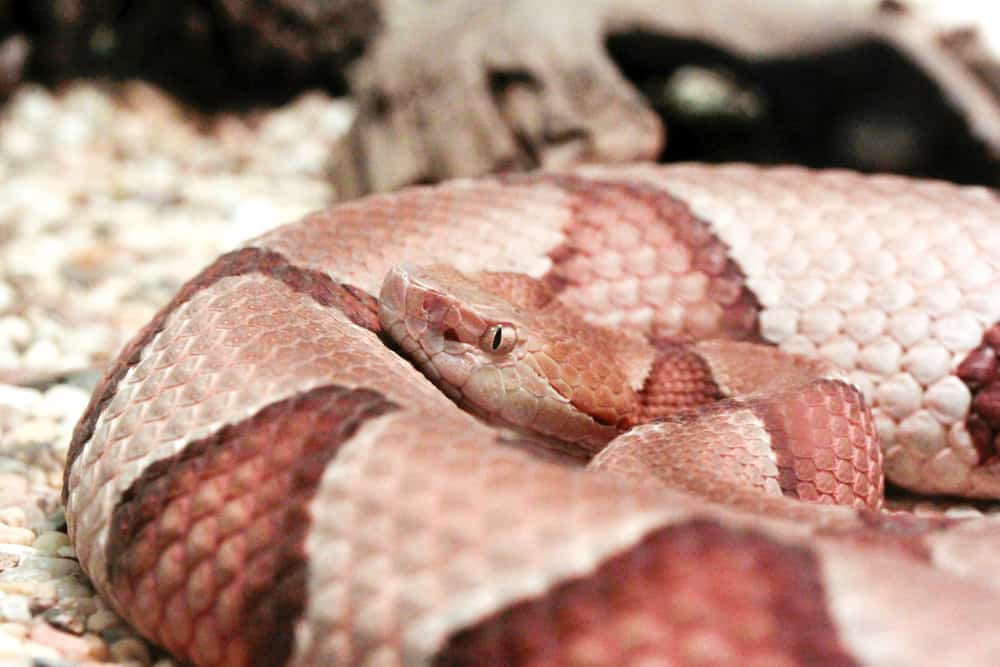
The copperhead snake in Arkansas gets its name from the coppery-bronze color of its head. The rest of the snake is colored in various shades of metallic brown.
| Scientific Name: | Agkistrodon contortrix |
| Range: | Throughout the state |
| Adult Size: | 24 to 36 inches |
| Description: |
A bright yellowish-green tail helps juveniles to lure prey closer. Strikingly colored in various shades of metallic brown. A large head with vertical pupils and heat-sensing pits between the eyes and nostrils. |
| Habitat: | Forests and overgrown hillsides |
| Venomous/Non-Venomous: | Venomous |
Northern Cottonmouth
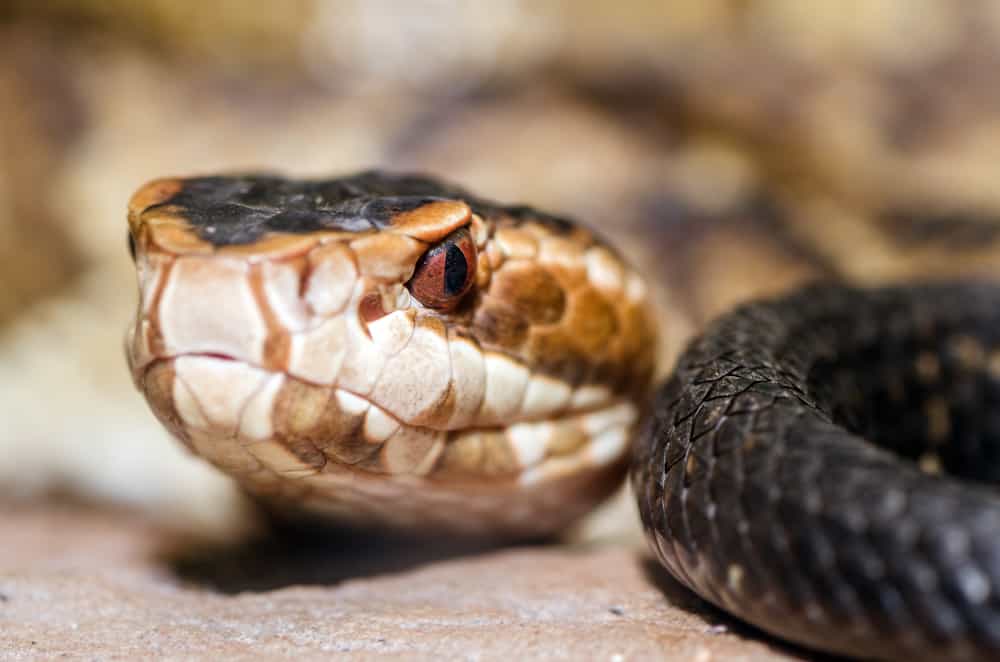
Unlike the rattlesnakes, the Cottonmouth of Arkansas doesn’t have a rattle. It’s a striking species with a bold pattern contrast and a bright white mouth interior.
| Scientific Name: | Agkistrodon piscivorus |
| Range: | Throughout the state |
| Adult Size: | 24 to 36 inches |
| Description: |
A bright yellow tail helps juveniles to lure prey within striking distance. Black or brown, and may have bands or blotches in a lighter coloration. A large head with vertical pupils, heat-sensing pits, and a bright white mouth interior. Light-colored stripes run down the sides of the face. |
| Habitat: |
Generalist, anywhere with enough moisture Often swamps and marshes |
| Venomous/Non-Venomous: | Venomous |
Western Diamond-backed Rattlesnake
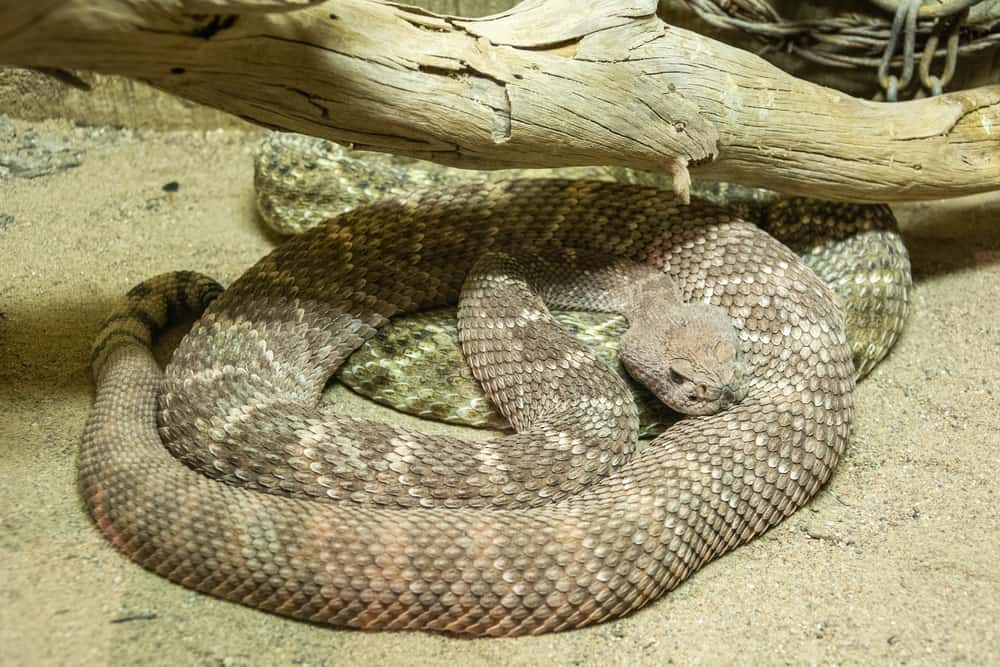
The Western diamondback rattlesnake is the largest of the North American pit vipers and has a pattern that distinguishes it from the other vipers.
| Scientific Name: | Crotalus atrox |
| Range: | The uplands of the Ouachita Mountains as well as the Southwestern part of the Ozark Highlands |
| Adult Size: | 36 to 72 inches |
| Description: |
Tail adapted to form a rattle. A very large snake with a gray-brown background covered in darker brown diamonds. Large head with vertical pupils and heat pits between the eyes and nostrils. |
| Habitat: | Rocky habitats, especially mountainsides and rocky scrublands |
| Venomous/Non-Venomous: | Venomous |
Timber Rattlesnake
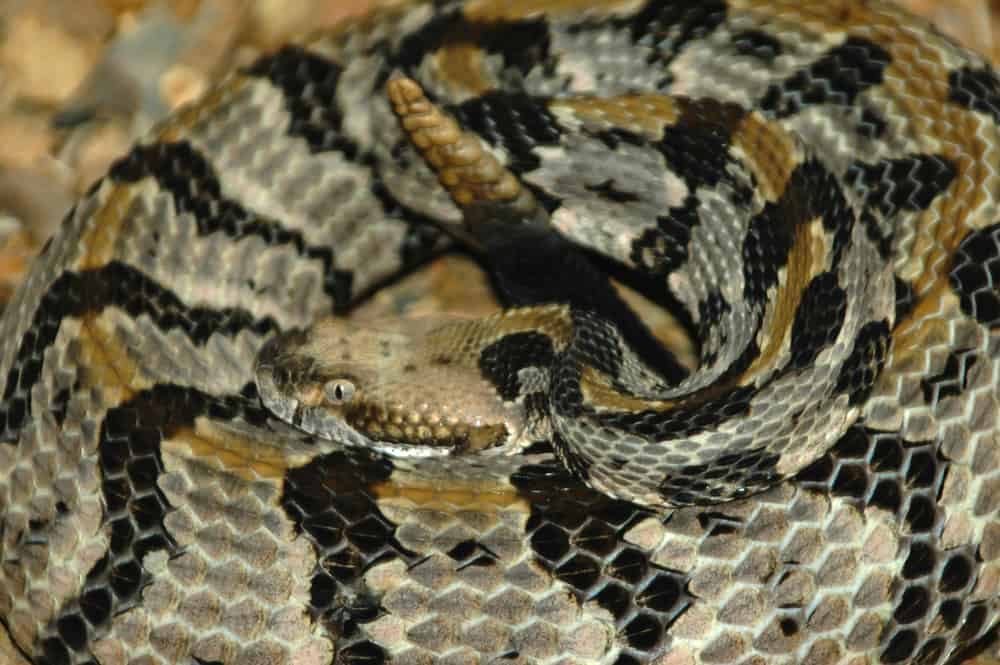
While not the biggest venomous snake in the region, the timber is still a sizable rattler. It prefers woodlands on the sides of mountains.
| Scientific Name: | Crotalus horridus |
| Range: | Throughout the state |
| Adult Size: | 36 to 60 inches |
| Description: |
Tail adapted to form a rattle. Large snake, light brown with dark brown markings and a light vertebral stripe. Wide head with large eyes featuring slit-shaped pupils and heat pits between the eyes and nostrils. |
| Habitat: | Forests, especially pine forests and deciduous forests, often on the sides of mountains |
| Venomous/Non-Venomous: | Venomous |
Pygmy Rattlesnake
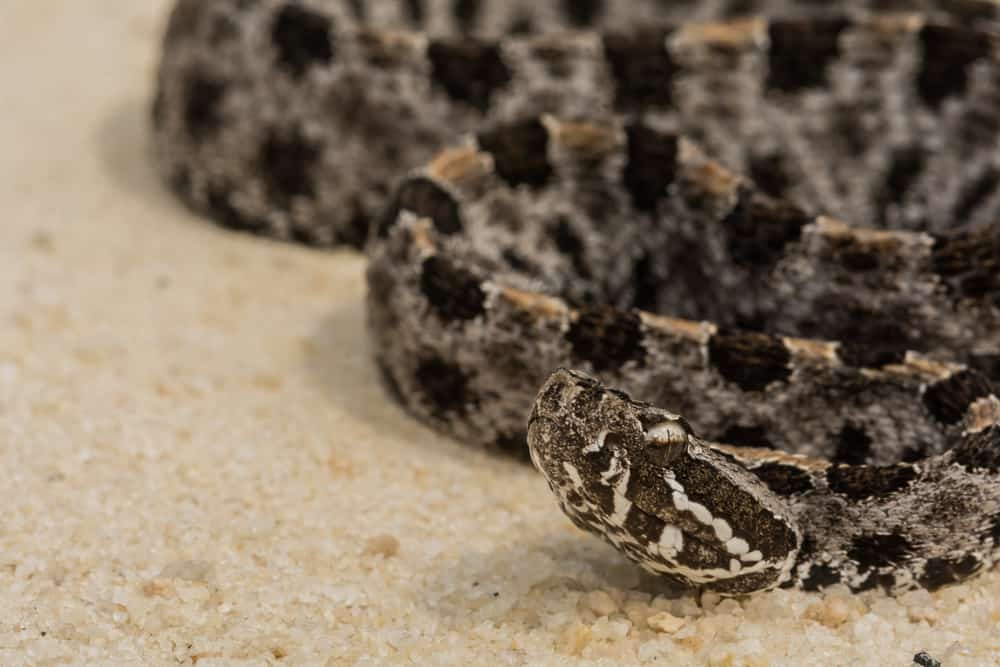
The pygmy rattlesnake is the smallest pit viper in the region but still packs a punch.
| Scientific Name: | Sistrurus miliarius |
| Range: | Throughout the state |
| Adult Size: | 15 to 20 inches |
| Description: |
Tail adapted to form a rattle. Heat-sensing pits between the eyes and nostrils. A small snake with a robust body, wide head, and slit-shaped pupils. Light brown with dark brown markings and an orange-brown vertebral stripe. Head boldly patterned with various stripes of dark brown and orange-brown. |
| Habitat: |
Open habitats, but with vegetation Often in bushy lowlands or semi-open forests |
| Venomous/Non-Venomous: | Venomous |
Texas Coral Snake
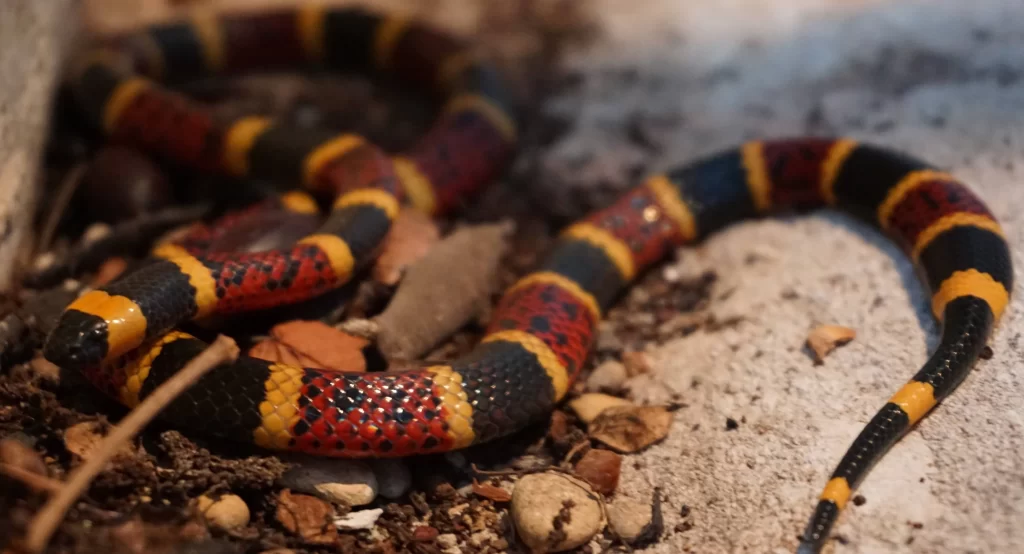
Image credit: u/Tridgeon (via Reddit.com)
This is a brightly colored species that is easy to distinguish from the other venomous snake species in the region. It’s a relative of the cobras, rather than a pit viper.
| Scientific Name: | Micrurus tener |
| Range: | The South of the state |
| Adult Size: | 20 to 30 inches |
| Description: |
A smallish, smooth-scaled snake with red, black, and yellow bands. A rounded face with small eyes and round pupils. |
| Habitat: | Prefers moist forest habitats with sandy soils |
| Venomous/Non-Venomous: | Venomous |
Non-Venomous Snakes in Arkansas
Most of the snakes in Arkansas are non-venomous snake species. We’ll take a look at a few noteworthy ones in the following sections.
Rough Greensnake
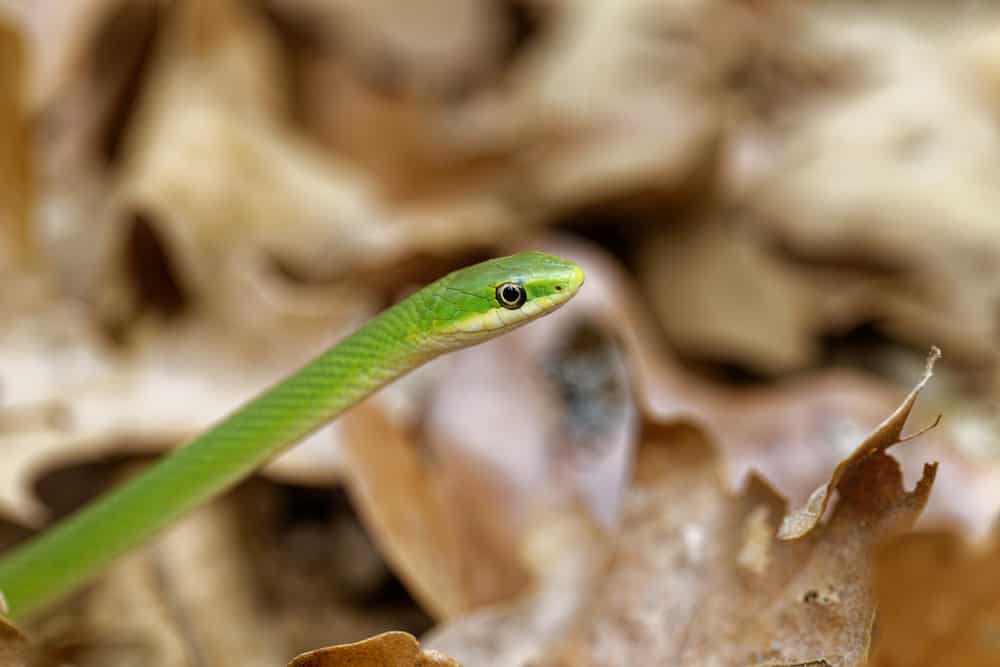
The rough greensnake gets its name from its color and its slightly keeled scales.
| Scientific Name: | Opheodrys aestivus |
| Range: | Throughout the state |
| Adult Size: | 22 to 32 inches |
| Description: |
A long green snake with keeled scales. The belly is white, yellow, or cream colored, as is the lower jaw. A sharp snout and slightly widened face with medium-sized eyes and round pupils. |
| Habitat: | Bushes and shrubs along the edges of freshwater habitats |
| Venomous/Non-Venomous: | Non-venomous |
North American Racer

The racer is one of the longest snakes in Arkansas.
| Scientific Name: | Coluber constrictor |
| Range: | Throughout the state |
| Adult Size: | 30 to 60 inches |
| Description: |
A long snake with a muscled but narrow body. May be black or brown, occasionally bluish, with a light belly and “chin”. Rounded face is the same width as the body, with medium-large eyes and round pupils. |
| Habitat: | Fields, forests, and the edges of woodlands |
| Venomous/Non-Venomous: | Non-venomous |
Ring-Necked Snake
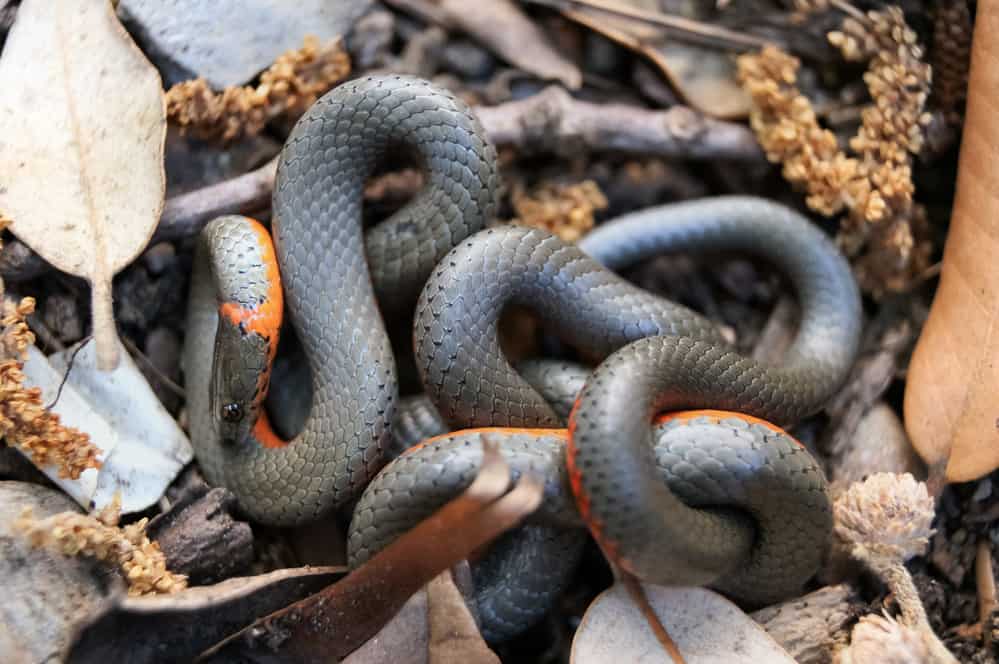
This snake gets its name from a singular, brightly-colored ring that wraps around its body.
| Scientific Name: | Diadophis punctatus |
| Range: | Throughout the state, but rarer in the far East |
| Adult Size: | 10 to 14 inches |
| Description: |
A small, thick-bodied snake. A single colored ring behind the head. Black or brown with a red, orange, or yellow belly. A rounded head with small eyes and round pupils. |
| Habitat: | Forests, woodlands, pastures, and glades |
| Venomous/Non-Venomous: | Non-venomous |
What You Need to Know
Most people fear snakes because they don’t understand them fully. People fear that snakes might eat them, or that they’re aggressive creatures that want to bite people.
Nothing could be further from the truth, and learning the truth helps to break down fear. Here’s what you should know:
- Most of the snakes in the region are non-venomous snakes.
- Snakes consider humans to be predators, not prey – they’ll run from you, and they won’t try to eat you.
- Not all venomous snakebites result in envenomation. Sometimes the snake bites without injecting venom.
- Thanks to the available antivenoms, venomous snakebites are rarely fatal – only around five of the 7,000 snakebites in the US annually are fatal.
- Most snakebites are the result of someone pestering a snake somehow, the others result from someone accidentally stepping on a snake.
Snake Safety 101
With a few basic precautions, it’s fairly easy to protect yourself and your loved ones from snake bites. You can follow these directions to keep you safe:
- Wear sturdy shoes when you go running or jogging.
- Stick to the marked, frequently used trails where you can easily spot a venomous snake.
- Keep your pets on leashes and your children near you whenever you visit parks or other semi-wild areas.
- Try never to enter overgrown or heavily vegetated areas where you can’t see what you’re stepping on and if the path is clear.
Above all, never catch, kill, taunt or bother any snakes that you find. If you don’t bother a snake, it’s unlikely to bother you.
About Venomous Snakes
In most regions, a venomous snake will try to avoid larger animals – including humans. However, in the United States, most venomous snakes are vipers.
From the Western pygmy rattlesnake to the water moccasin, the vipers in the US rely on camouflage to protect them.
Unfortunately, that makes them easy to step on, since the dark gray and light brown background colors of these animals allow them to blend seamlessly.
With their potent venom, you want to avoid that. Apart from accidents, or situations where people bother the snake, bites are rare.
If you stick to our safety recommendations above, you’re unlikely to have problems with venomous or non-venomous snakes.
If You Encounter a Snake
Nine times out of ten, you won’t need to do anything if you encounter a snake. If you happen to be too close to a snake when you find it, simply back away.
If you blunder into a snake, and it seems angry, stand absolutely still. Moving quickly is certain to lead to disaster. Wait for it to calm down, and it should just leave.
Other than that, feel free to observe it from a safe distance, and take photos. Never taunt a snake in any way, and if it needs to be removed call a professional.
When to Call for Help
There are only two situations when you’ll need to call for help because of a snake, namely:
- If the snake is in danger or poses a danger to someone else
- If you or someone else has been bitten by a snake
If you encounter either of these situations, use the details in the resource section to contact the relevant authorities.
Useful Resources
I’ve made a list of some of the most useful resources that you might need when dealing with a snake.
Emergency Poisoning Advice
- Poison Control Center’s national hotline: 1-800-222-1222
- ASPCA Poisoning Hotline: 1-888-426-4435
Snake Relocation Services
If a snake is somewhere where it might get hurt or hurt someone else, you can have it relocated.
Consider phoning your regional office for the Arkansas Game & Fish Commission. They can put you in touch with a professional snake handler in your area.
You can also make use of the Free Snake Relocation Directory on Facebook.
Educational Resources
There are many resources you can use when trying to learn more about snakes.
The Arkansas snake guide by the Arizona Game & Fish Commission is an excellent starting point. It discusses all the native snakes in intense detail.
You can also learn a lot from iNaturalist. This site helps you to identify plants and wildlife, as well as to connect with other wildlife enthusiasts.
Related Articles to Arkansas Snakes Identification Guide
If our Arkansas snake guide has you interested in other Identification guides, check out our:
- Texas Snakes Identification Guide
- Florida Snakes Identification Guide
- California Lizards Identification Guide
You can also check out our other articles on snakes – we have vital guides that you can learn from!
